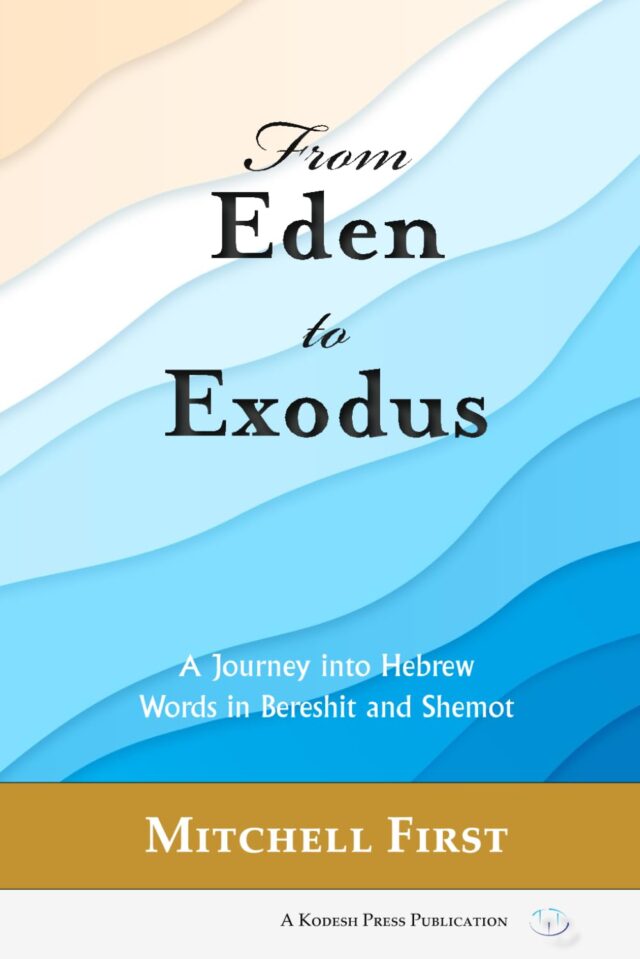Mollie Kidorf Fisch
Review of Mitchell First, From Eden to Exodus: A Journey into Hebrew Words in Bereshit and Shemot (Kodesh Press, 2024).[1]
Mitchell First is a noted author, and this is his sixth book. The first, Jewish History in Conflict (Jason Aronson, Inc., 1997), deals with a single topic: the length of the Second Temple period. The second, Esther Unmasked (Kodesh Press, 2015), comprises 11 essays, and is based on articles he had previously published in Hakirah and seforimblog.com. Next, he published three books based on his Jewish Link columns, each with approximately 60 short articles about history, liturgy, holidays, and etymology: Roots and Rituals (Kodesh Press, 2018), Links to Our Legacy (Kodesh Press, 2021), and Words for the Wise (Kodesh Press, 2022).
From Eden to Exodus: A Journey into Hebrew Words in Bereshit and Shemot is his newest book. It is written mostly in a parashah-based format, and is dedicated to the memory of his close friend of many years, Sam Borodach. In First’s tribute, he credits Borodach for the insightful feedback he received during their years of friendship, which enhanced his written work.
This book covers Bereshit and Shemot in Parts 1 and 2, usually devoting two essays per parashah, although in some cases, (Bereshit and Va-Yehi; Shemot, Beshalah, and Mishpatim) three essays are presented, and for Miketz, Va-Yakhel, and Pekudei, just one. As is evident from the book’s subtitle, his main focus in these sections is on etymology-related issues. Starting with the root, he explores its meanings, often traces it to its source, and follows its connection to other apparently potentially related words in Tanakh – e.g., dam, adom, adamah, adam, and Edom. First presents various scholars’ viewpoints on each word he investigates. In many instances, he finds no single, definitive answer but, instead, many intriguing possibilities. As the author notes, the array of scholarly opinions provides fertile ground for homiletics. He touches briefly on wordplay, e.g., lashon nofel al lashon, a literary feature that appears throughout Tanakh. By juxtaposing similar sounding words in the text that are not necessarily related etymologically, Tanakh provides an enriching and engaging experience for the careful reader. One example that First cites is Edom for Eisav as related to “ruddy” (adom) (4), a form of wordplay.
In the Bereshit chapters, I particularly liked First’s discussion on the etymology of melekh (king), addressed in his essay on Parashat Lekh Lekha (since the “battle of the kings” is found in this parashah) (21-23). In leading us to attempt to determine the underlying verb of melekh, he provides background rather than simply providing conclusions. In this way, he allows the readers to follow along on his journey of investigation. First takes the reader to Aramaic and Akkadian sources, to standard references including Brown-Driver-Briggs, Ernest Klein, Marcus Jastrow, and Matityahu Clark, and then segues over to Samuel David Luzzatto and R. Shamshon Refael Hirsch. He points out that in Aramaic, aside from the “rule” meaning, the verb has meanings like “decide,” “advise,” and “consult.” He also points out that many relate the “king” meaning to the above meanings. Others, however, reject any connection between these meanings. Although First does not reach a clear conclusion on the underlying root of the word, he points out that S.D. Luzzatto (commenting on Gen. 36:31) makes the interesting suggestion that it derives from molikh (leader), which is from the root h-l-kh..
In the same essay, the author also mentions the similarity between melekh and Molekh, the name of a pagan god mentioned eight times in Tanakh. He states that most scholars relate the name of this pagan god to the “king” meaning. Finally, in a postscript, he writes briefly about the etymology of the English word king.
The beginning of Parashat Hayei Sarah introduces the root s-p-d, as in lispod, which is often translated as “to eulogize.” Recognizing that this is a later mishnaic meaning, First checked several Bible translations. In an early JPS edition and the Hertz chumash it is translated as “to mourn,” but he saw that Rabbi Hertz had commented in his text that “The Hebrew word (lispod) indicates the loud wailing still usual in the East as a manifestation of grief.” Hiring a professional mourner may also have been part of this practice, and is mentioned by Jeremiah (9:16). A grief ceremony that involves trembling and body movement is cited in Daat Mikra, while the Theological Dictionary of the Old Testament further describes a grief ceremony that involves beating the breasts while crying out “ho, ho” (as is seen in Amos ch. 5, portraying a scene of great mourning, and in association with the word misped). Sefod appears in Kohelet 3:4 as a contrast to rekod (dancing), and misped contrasts with mahol (also dancing) in Psalm 30:12. The ceremonial explanation, says First, aids our comprehension of these contrasts.
Next, First traces the root s-p-d to the Akkadian source, where it means mourning, and also means to “beat the breasts,” which First suggests is probably its original meaning. He cites several sources, e.g., Tawil’s Akkadian Lexical Companion for Biblical Hebrew, the Theological Dictionary of the Old Testament, the etymological works of Ernest Klein, and Marcus Jastrow, who seems to believe that “beats or strikes” is the original meaning. First searches Tanakh for a proof text, and quotes a verse in Isaiah (32:12). The prophet has called upon the women to mourn immediately for the approaching calamities, saying, “Al shadayim sofdim, (“Lament on breasts”), for the pleasant fields, for the fruitful vine.” Since we now know of an ancient Near Eastern grief ceremony that involves beating of the breasts, and we have an Akkadian root, we may have found the answer to this difficult line of text, puzzled over by many mefarshim (commentators) whom First lists in his discussion of “beating the breasts” as a sign of mourning.
In the section on Shemot, the title of a Va-Era chapter caught my eye: John Lennon and the Plague of Arov. First notes that the word arov simply means mixture, but does not specify the variety. He goes on to cite interpretations that range from a mixture of wild animals, to insects (from a Latin root), then to night wolves and scarab beetles (but definitely not “Beatles”!)
Part 3: Miscellaneous Essays presents six additional short chapters or sections that are unrelated to the parashah; instead, the author suggests that they can be read leisurely during the seasons of Va-Yikra, Bemidbar, and Devarim!
I was intrigued by First’s chapter in this section on the word anak (176-179). It sometimes is a word for a race of giants. Other times, it has the meaning “necklace.” He explains that most likely there is a connection here. In ancient times, when people saw a tall person, they called him an anak, because a tall person gave the impression of having a long neck. Indeed, in Arabic, their cognate to anak means “neck.” (First states that R. Hirsch on Devarim 2:11 figured out the necklace-giant connection, even though he did not know of that clue from Arabic.)
By carefully delving into the roots of significant words in the text, the author imparts an extra layer of meaning, sometimes offering a new approach to a long-held understanding of a word or a phrase, which may even impact our understanding its meaning in other contexts, and may enhance our appreciation of prayer texts.
For example, in the second paragraph of the Aleinu prayer, First asks if the word le-taken is spelled with a kuf (to perfect) or a kaf (to establish) (173-176). He notes that in the siddurim most of us use, whether nusach Ashkenaz or Sefarad, tav-kuf-nun is the common spelling, and he reminds us that tikkun olam is a Jewish value and human action referred to many times in the Mishnah. But then he learned from a shul friend that the Yemenite siddur has le-taken (to establish) spelled with a kaf, obviously referring the action to God who establishes and maintains the world. Discovering this difference led First on a search to try and determine which version is the original: kuf or kaf. When he looked in Rambam’s Sefer Ahavah, using modern critical editions based on manuscripts, and 10th-13th century Aleinu scripts from the Cairo Genizah, he found the word spelled with a kaf. A manuscript of the R. Saadia Gaon Rosh Hashanah Amidah prayer also shows a kaf spelling. However, although R. Saadia lived in the 10th Century (d. 942), our manuscript is a later document. Ashkenazic texts from the time of the Rishonim, such as Mahzor Vitry (12th century) more typically have a kuf spelling. Although First cannot prove definitively (to date!) that kaf was the earlier spelling, he argues strongly that the kaf spelling (to establish) is a better reading in the context of the prayer, and thinks it more likely that kaf would have evolved to kuf, rather than the opposite.
Later, in reviewing this research, which he had already published, First realized that there was a much more significant question to address in the Aleinu prayer: who was to do the le-taken action, man or God? Many of us may automatically assume that “tikkun olam” is a responsibility to be shouldered by the Jewish people. But looking at the word in isolation must be balanced by its inclusion in the full section of text: “Al kein nekaveh lekha Hashem Elokeinu, lirot meheira[h] be-tiferet uzekha, le-haavir gilulim min ha-aretz, ve-ha-elilim karot yikareitun, le-taken olam bemalkhut Sha-dai ….” First says that “lirot meheira[h] be-tiferet uzekha” is almost certainly a request for the speedy rebuilding of the Beit ha-Mikdash, citing sources in Psalms for variations on “tiferet uzekha” that clearly refer to the Beit ha-Mikdash, and he points to “meheira[h]” (speedily) as confirmation to his theory. He then states that this excerpt is a prayer for rebuilding the Temple and establishing God’s kingdom on earth. The next step is to find out who is the actor, God or the Jewish people, and he concludes that only God is capable of removing gilulim (idols) and cutting off elilim (other gods). To strengthen his theory, he quotes Rabbi Jonathan Sacks and the scholar Gerald Blidstein, who both point to this as a prayer by the people to God, expressing our hope that He will take the action(s) cited. Both of these modern scholars are referring to the word le-taken with a kuf.
I find the path of discovery described by the author, the range and scope of his sources over the centuries, and his willingness to correct and enlarge upon his own earlier works, a testimony to his intellectual curiosity, his honesty, and his interest in following the line of mesorah from generation to generation.
I am pleased to say that From Eden to Exodus meets the high standard of Mr. First’s previous books. He has once again produced a scholarly work, replete with references (including many cross-references to his earlier books). It is written in a congenial, conversational tone. His writing is easy to understand, and he delivers an intellectually compelling body of information that readers who love textual Bible study will enjoy. They will learn many things about which they might never even have thought to ask.
[1] All parenthetical citations refer to this volume.










 Site Operations and Technology by The Berman Consulting Group.
Site Operations and Technology by The Berman Consulting Group.